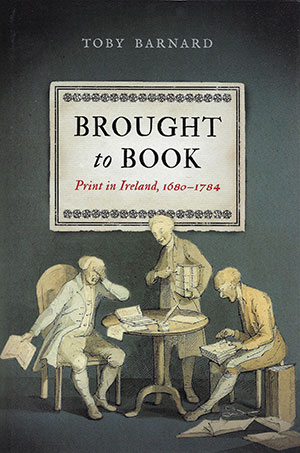Brought to book: print in Ireland, 1680–1784
Published in Book Reviews, Book Reviews, Issue 6 (November/December 2017), Reviews, Volume 25TOBY BARNARD
Four Courts Press
€50
ISBN 9781846826290
Reviewed by Eamon Darcy
Eamon Darcy lectures in history at Maynooth University and is the author of The world of Thomas Ward: sex and scandal in late seventeenth-century Co. Antrim.

The purpose of this volume is to investigate how Irish people encountered and engaged with the world of print and the publishing trade during the late seventeenth and eighteenth centuries. Any study of print and its reception is fraught with difficulty,owing to the nature of the evidence and the scarcity of accounts that offer more than anecdotal stories or tentative glimpses into the world of reading and print, a problem that Toby Barnard frequently laments. The production of printed materials almost exclusively in English during this time further complicates the picture. There is no satisfactory way to measure the circulation of Irish manuscripts and Irish-language tracts published on the Continent in Ireland alongside English-language publications. What is clear from Barnard’s work is that Irish people engaged with prevailing British and European print cultures and that provincial presses slowly emerged in the eighteenth century that reflected, and sometimes rejected, these prevailing trends. The sheer volume of English-language material produced during this time prompts Barnard to argue, reasonably, that while the Anglophone world was more accessible to Irish audiences ‘Ireland did not become English’ (p.22) and that engagement with this world did not make ‘those thus engaged more tractable’ (p.298). At times Barnard attempts to integrate Irish-language tracts, and the role of bilingual interpreters who may have disseminated English-language publications in Irish, into his account, but his focus is predominantly on the Anglophone world in Ireland.
Studies of print often focus on its production in metropolitan cores, but Barnard moves beyond Dublin and London and offers impressive detail on the complexities of disseminating printed ideas in the provinces. In Dublin, and other port towns and cities such as Belfast, Cork, Drogheda and Waterford, book-lovers could browse booksellers’ shelves or request copies from their correspondents across Ireland, Britain and Europe. Two chapters delve into the world of print production in ‘The South’ and ‘The North’ and underline how provincial presses became part of the fabric of local politics and culture. By the 1750s Cork could sustain two newspapers, and in 1755 the municipality burned a Cork edition of the antiquarian Charles O’Conor’s defence of Catholics (pp 274–5). Meanwhile, in Ulster parliamentary candidates appealed for votes in the Belfast News-Letter (pp 313–14). Of course, it must be remembered that, while provincial presses were a boon for local authors, the Dublin and London presses were far more prestigious, with the latter offering greater legal and financial protections and incentives for budding writers—hence many prominent authors, most notably Jonathan Swift, preferred to print there.
Brought to book covers a wide range of topics and this allows Barnard to view the 1720s as a pivotal decade. In the political realm the dispute over Wood’s halfpence marked the increasing reliance on print by political figures to denigrate rivals and promote their own agendas, which shaped future political participation. In terms of devotional literature, Catholics began to produce English-language books, and this decade also marked the first Irish printing of Shakespeare’s work in both Cork and Dublin. Such detail hints at the broad ground covered by Barnard. There are chapters dedicated to devotional, educational and recreational literature, and the book provides rich, albeit at times anecdotal, detail on the dissemination of print and its reception. As the number of newspapers grew, readers were exposed to global news events more regularly, but they also became increasingly sceptical about what they had read. Understandably, cultural, religious and political outlooks shaped the content and reception of print, and three chapters that look at the publication of histories, contemporary commentaries and proposals to reform the country strongly illustrate the underlying sectarian and political issues that blighted scholarly and popular debates throughout this time.
Barnard’s latest work must be complimented for its meticulous attention to detail, although this is a double-edged sword. There is an abundance of evidence from a range of archives. Those who are willing to comb through the footnotes will be rewarded for their efforts, but the sheer volume of citations and their presentation in the text, which lacks a bibliography, may deter some readers. Furthermore, while the book is rich in detail and covers a lot of ground, it is in places difficult to discern an argument. This is understandable, given the broad and ambitious remit of the book and the mixed chronological and thematic approach adopted. The overall clarity of the volume sometimes suffers as a result. The conclusion is perhaps the best place for the reader to start, as Barnard outlines the key parameters of the debate and highlights areas that require further investigation. Overall, Brought to book is a product of years of painstaking research that uncovers the practicalities of printing and the quirks of the trade, complete with the occasional and entertaining dry-witted quip. It offers vivid detail about the Anglophone printed world while reminding us that this needs to be integrated into broader Irish and oral cultures in Ireland; it will, undoubtedly, inspire future generations to think about books and print production in Ireland in more nuanced ways.
















